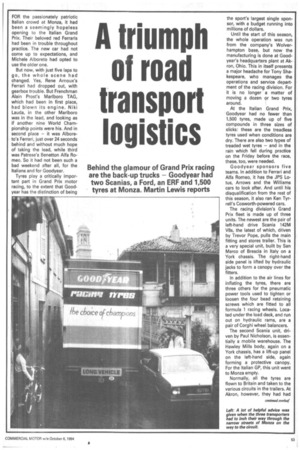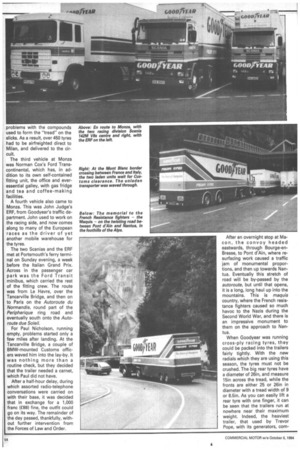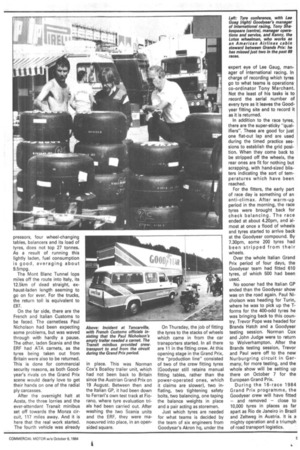A triumph of road transport logistics
Page 57

Page 58

Page 59

If you've noticed an error in this article please click here to report it so we can fix it.
FOR the passionately patriotic Italian crowd at Monza, it had been a seemingly hopeless opening to the Italian Grand Prix. Their beloved red Ferraris had been in trouble throughout practice. The new car had not come up to expectations, and Michele Alboreto had opted to use the older one.
But now, with just five laps to go, the whole scene had changed. Yes, Rene Arnoux's Ferrari had dropped out, with gearbox trouble. But Frenchman Alain Prost's Marlboro TAG, which had been in first place, had blown its engine. Niki Lauda, in the other Marlboro was in the lead, and looking as if another nine World Championship points were his. And in second place — it was Alboreto's Ferrari, just over 24 seconds behind and without much hope of taking the lead, while third was Patrese's Benetton Alfa Romeo. So it had not been such a bad weekend after all, for the Italians and for Goodyear.
Tyres play a critically important part in Grand Prix motor racing, to the extent that Goodyear has the distinction of being the sport's 'largest single sponsor, with a budget running into millions of dollars.
Until the start of this season, the whole operation was run from the company's Wolver hampton base, but now the manufacturing is done at Good year's headquarters plant at Ak ron, Ohio. This in itself presents a major headache for Tony Sha kespeare, who manages the operations and service department of the racing division. For it is no longer a matter of moving a dozen or two tyres around.
At the Italian Grand Prix, Goodyear had no fewer than 1,500 tyres, made up of five compounds in three sizes of slicks: these are the treadless tyres used when conditions are dry. There are also two types of treaded wet tyres — and in the rain which fell during practice on the Friday before the race, these, too, were needed.
Goodyear sponsors five teams. In addition to Ferrari and Alfa Romeo, it has the JPS Lotus, Arrows and the Williams cars to look after. And until his disqualification from the rest of this season, it also ran Ken Tyrrell's Cosworth-powered cars.
The racing division's Grand Prix fleet is made up of three units. The newest are the pair of left-hand drive Scania 142M V8s, the latest of which, driven by Trevor Pope, pulls the main fitting and stores trailer. This is a very special unit, built by San Marco of Brescia in Italy on a York chassis. The right-hand side panel is lifted by hydraulic jacks to form a canopy over the fitters.
In addition to the air lines for inflating the tyres, there are three others for the pneumatic power tools used to tighten or loosen the four bead retaining screws which are fitted to all formula 1 racing wheels. Located under the load deck, and run out on hydraulic rams, are a pair of Corghi wheel balancers.
The second Scania unit, driven by Paul Nicholson, is essentially a mobile warehouse. The Hawley Mills body, again on a York chassis, has a lift-up panel on the left-hand side, again forming a protective canopy. For the Italian GP, this unit went to Monza empty.
Normally, all the tyres are flown to Britain and taken to the various circuits in the trailers. At Akron, however, they had had problems with the compounds used to form the "tread" on the slicks. As a result, over 450 tyres had to be airfreighted direct to Milan, and delivered to the circuit.
The third vehicle at Monza was Norman Cox's Ford Transcontinental, which has, in addition to its own self-contained fitting unit, the office and everessential galley, with gas fridge and tea and coffee-making facilities.
A fourth vehicle also came to Monza. This was John Judge's ERF, from Goodyear's traffic department. John used to work on the racing side, and now comes along to many of the European races as the driver of yet another mobile warehouse for the tyres.
The two Scanias and the ERF met at Portsmouth's ferry terminal on Sunday evening, a week before the Italian Grand Prix. Across in the passenger car park was the Ford Transit minibus, which carried the rest of the fitting crew. The route was from Le Havre, over the Tancarville Bridge, and then on to Paris on the Autoroute du Normandie, round part of the Peripherique ring road and eventually south onto the Autoroute due So/oil.
For Paul Nicholson, running empty, problems started only a few miles after landing. At the Tancarville Bridge, a couple of BMW-mounted Customs officers waved him into the lay-by. It was nothing more than a routine check, but they decided that the trailer needed a carnet, which Paul did not have.
After a half-hour delay, during which assorted radio-telephone conversations were carried on with their base, it was decided that in exchange for a 1,000 franc (EH) fine, the outfit could go on its way. The remainder of the day passed, thankfully, without further intervention from the Forces of Law and Order.
After an overnight stop at Mac o n , the convoy headed eastwards, through Bourge-enBresse, to Pont d'Ain, where resurfacing work caused a traffic jam of monumental proportions, and then up towards Nantua. Eventually this stretch of road will be by-passed by the autoroute, but until that opens, it is a long, long haul up into the mountains. This is maquis country, where the French resistance fighters caused so much havoc to the Nazis during the Second World War, and there is an impressive monument to them on the approach to Nantua.
When Goodyear was running cross-ply racing tyres, they could be packed into the trailers fairly tightly. With the new radials which they are using this season, the tyres must not be crushed. The big rear tyres have a diameter of 26in, and measure Thin across the tread, while the fronts are either 25 or 261n in diameter with a tread width of 9 or 8.5in. As you can easily lift a rear tyre with one finger, it can be seen that the trailers run at nowhere near their maximum weight. Indeed, the heaviest trailer, that used by Trevor Pope, with its generators, com
pressors, four wheel-changing tables, balancers and its load of tyres, does not top 27 tonnes. As a result of running this lightly laden, fuel consumption is good, averaging about 9.5mpg, The Mont Blanc Tunnel lops miles off the route into Italy, its 12.5km of dead straight, exhaust-laden length seeming to go on for ever. For the trucks, the return toll is equivalent to E87.
On the far side, there are the French and Italian Customs to be faced. The carnetless Paul Nicholson had been expecting some problems, but was waved through with hardly a pause. The other, laden Scania and the ERF had ATA carnets, as the tyres being taken out from Britain were also to be returned. This is done for commercial security reasons, as both Goodyear's rivals on the Grand Prix scene would dearly love to get their hands on one of the radial ply carcasses.
After the overnight halt at Aosta, the three lorries and the ever-attendant Transit minibus set off towards the Monza circuit, 117 miles away. And it is here that the real work started. The fourth vehicle was already in place. This was Norman Cox's Boalloy trailer unit, which had not been back to Britain since the Austrian Grand Prix on 19 August. Between then and the Italian GP, it had been down to Ferrari's own test track at Fiorano, where tyre evaluation trials had been carried out. After washing the two Scania units and the ERF, they were ma noeuvred into place, in an opensided square. On Thursday, the job of fitting the tyres to the stacks of wheels which came in from the car transporters started. In all there are 11 in the fitting crew. At this opening stage in the Grand Prix, the "production line" consisted of two of the crew fitting tyres (Goodyear still retains manual fitting tables, rather than the power-operated ones, which it claims are slower), two inflating, two tightening safety bolts, two balancing, one taping the balance weights in place and a pair acting as storemen.
Just which tyres are needed for what teams is decided by the team of six engineers from Goodyear's Akron hq, under the
expert eye of Lee Gaug, manager of international racing. In charge of recording which tyres go to what teams is operations
co-ordinator Tony Marchant. Not the least of his tasks is to record the serial number of every tyre as it leaves the Goodyear fitting site and to record it as it is returned.
In addition to the race tyres, there are the super-sticky "qualifiers". These are good for just one flat-out lap and are used during the timed practice sessions to establish the grid position. When they come back to be stripped off the wheels, the rear ones are fit for nothing but scrapping, with hand-sized blisters indicating the sort of temperatures which have been reached.
For the fitters, the early part of race day is something of an anti-climax. After warm-up period in the morning, the race tyres were brought back for check balancing. The race ended at about 4.20pm, and 'almost at once a flood of wheels and tyres started to arrive back at the Goodyear compound. By 7.30pm, some 200 tyres had been stripped from their wheels.
Over the whole Italian Grand Prix period of four days, the Goodyear team had fitted 610 tyres, of which 500 had been used.
No sooner had the Italian GP
ended than the Goodyear show was on the road again. Paul Nicholson was heading for Turin, where he was to pick up the Tforms for the 400-odd tyres he was bringing back to this country. Trevor Pope was headed for Brands Hatch and a Goodyear testing session. Norman Cox and John Judge were to return to Wolverhampton. After the Brands testing session, Trevor and Paul were off to the new Nurburgring circuit in Germany, for more testing, and the whole show will be setting up there on October 7 for the European Grand Prix.
During the 16-race 1984 Grand Prix programme, the Goodyear crew will have fitted — and removed — close to 10,000 tyres in places as far apart as Rio de Janeiro in Brazil
and Zeltweg in Austria. It is a mighty operation and a triumph of road transport logistics.




























































































































































